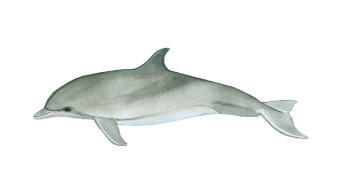
Common Bottlenose dolphin
(Tursiops truncatus)
Probably the most well-known of all dolphin species because of its vast distribution and prevalence in captivity as well as its frequent appearance in TV series such as the famous Flipper. Scientific discoveries suggest that these dolphins are highly intelligent and have complex social behaviour.
They have self-awareness (can recognise their reflection in a mirror), can solve problems and in some areas they have even been observed using ‘tools’ or playing with fish, algae or objects floating at the surface. Depending on the population and the area of occurrence, the different Bottlenose dolphin species from the genus Tursiops vary in appearance and size.
To our knowledge, these animals can reach an age of up to 30 years or more and can dive to depths of about 550 metres.
Listen below:
General information
Further names: Portuguese: Golfinho-roaz
Size of adults: 1.9 – 3.9 m
Prey: Fish, cephalopods, crustaceans.
Behaviour: Very active and playful at the surface. They often curiously approach boats and leap, bowride and stick their heads out of the water. They are often seen associating with other species and have been encountered in the company of other cetacean species, sea turtles and sharks. Solitary adults are known to stay in one area, often even seeking human contact.
Range: Global, temperate and tropical regions.
Madeira: Occur all year round.
Distinctive features: Robust animals, dark grey on the back, paler on the belly. The dorsal fin is clearly identifiable and sickle-shaped. They have a prominent round forehead and a relatively short, bottle-shaped beak that stands out at a sharp angle. The population of this species in Madeira consists of two ecotypes; the larger, pelagic offshore type and the smaller, coastal type with the latter community even containing resident groups.
Taxonomy: Suborder: Odontoceti (Toothed whales), Family: Delphinidae (Dolphins)
Threats: Not threatened. They do, however, have a high mortality rate due to bycatch and the increasing pollution of the oceans e.g. with chemicals. Other threats include exploitation by fishermen in Japan and other countries, who regard dolphins as competition for food and kill them. In Taiji, Japan, fishermen capitalise even further on the animals they herd together and pick out the ones best suited for captivity, that are then sold to dolphinariums at high prices, before slaughtering the remaining animals. The Academy-Award winning documentary ‘The Cove’ explains this horrific event and shows the brutal practice of the dolphin butchers in Taiji.
The population of Bottlenose dolphins in the Black Sea is considered endangered.
